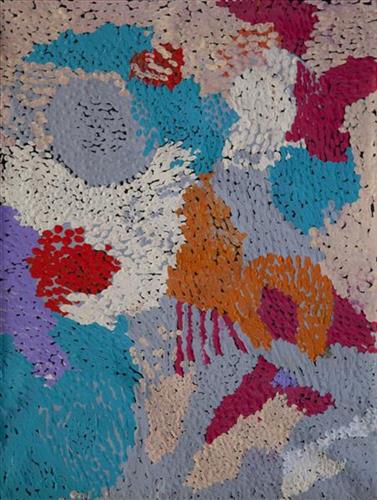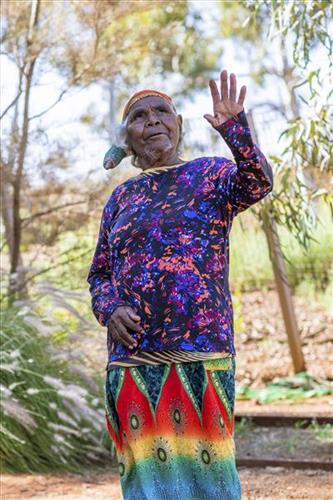111582251273
Little Claypan
“[As a young girl] I walked around and went east back to my dad’s area, to Pitu and Nyingkul, Kulilu. Nyakaly and Kunapila. Then I was a teenager. [At] Kunapila, gum trees grow around. I go [went] to this place with my parents and Jakayu’s family, we catch kangaroo here. Always water here.”
– Ngamaru Bidu
Kunapila is the site of a large permanent linyji (claypan) and soak located at the south eastern border of the Karlamilyi River (Rudall River) region. There is also a large, distinctive yapu (hill) at Kunapila. This site lies within Ngamaru’s ngurra (home Country, camp), the area which she knew intimately and travelled extensively with her family in her youth. At this time Ngamaru’s family would regularly meet around here with fellow Martumili Artist, Jakayu Biljabu, and her family. Ngamaru’s younger brother was born in this region.
During the pujiman (traditional, desert dwelling) period, Martu would traverse very large distances annually in small family groups, moving seasonally from water source to water source, and hunting and gathering bush tucker as they went. At this time knowledge of water sources was critical for survival, and today Martu Country is still defined in terms of the location and type of water. Each of the hundreds of claypans, rockholes, waterholes, soaks and springs found in the Martu desert homelands is known by name, location, quality and seasonal availability through real life experience and the recounting of Jukurrpa (Dreaming) narratives.
Kunapila features in the Wati Kujarra (Two Goanna Men) Jukurrpa, a central creation narrative for Martu. The Wati Kujarra existed as half men, half goanna. They were responsible for the creation of many land features in Martu Country and beyond as they travelled, hunted and burned Country together. At Kunapila the Wati Kujarra saw two parnajarrpa (goannas), one large and one small. The men painted themselves and the goannas, one with black ochre and the other with brown. They continued on their journey from here. In this story both the mens’ and goannas’ skin groups (Purungu and Milanka) are of relevance




